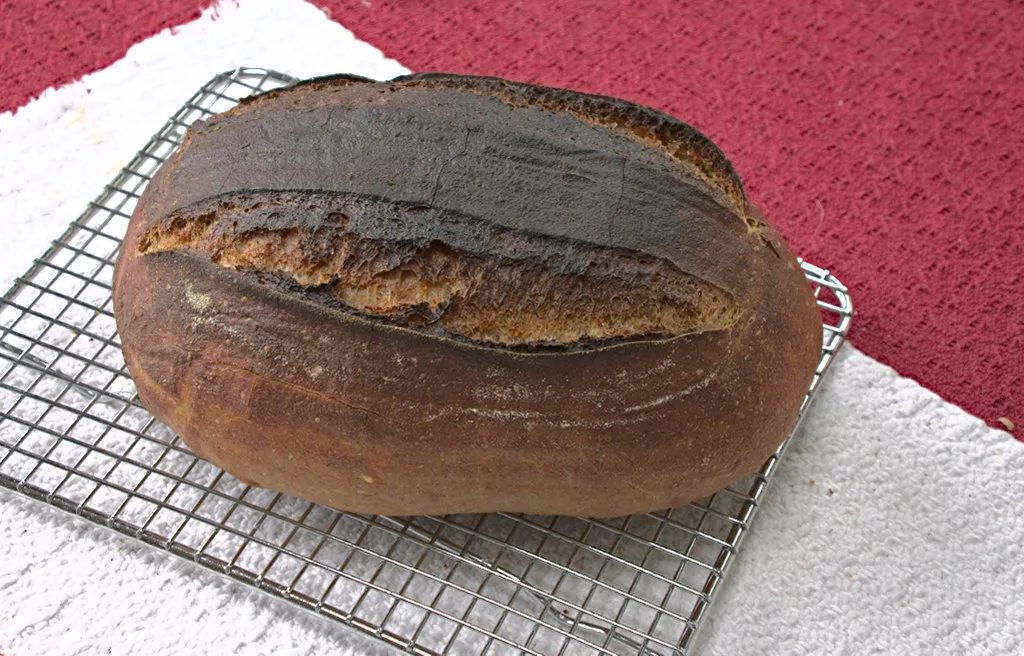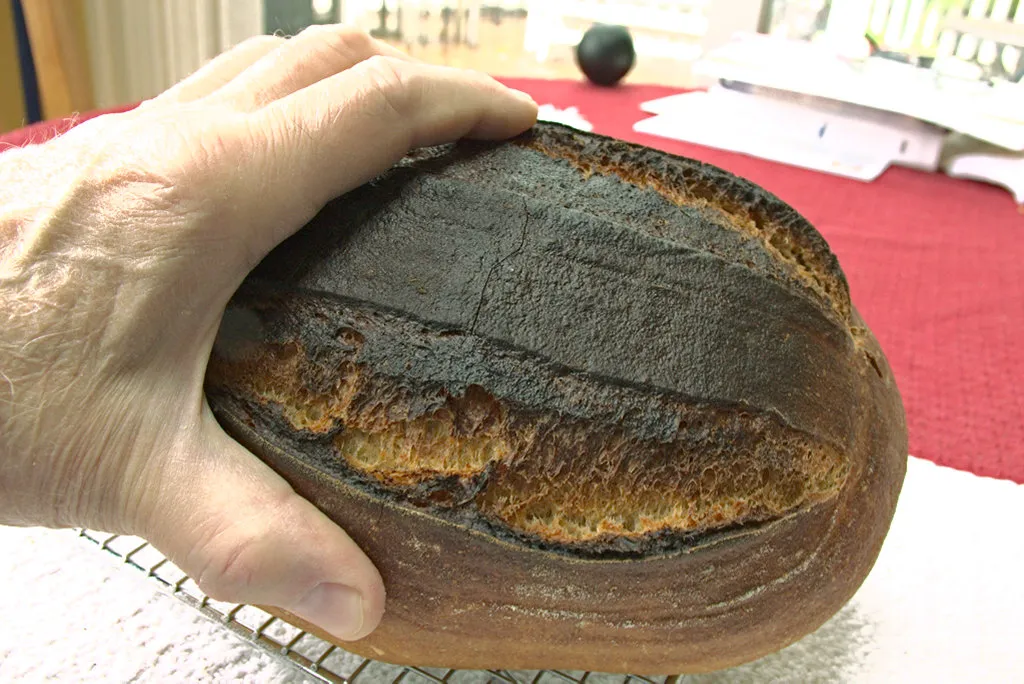
Recently I've posted about bakes using 50% spelt and 50% einkorn:
https://www.thefreshloaf.com/node/72911/50-einkorn-take-2
https://www.thefreshloaf.com/node/72889/50-spelt
Today's loaf used the third "ancient" grain - emmer. I've never used it before.
As for the other two flours, this emmer was stoneground by a local restored water mill (Locke's Mill in northwestern Virginia). The bits of bran were much smaller than with the einkorn flour, and I had to use a finer sieve to remove them. I ended up with about a 94% extraction, made a soaker with the bran, and added the soaker to the flour during mixing.
The formula was the same as I used for the einkorn loaf, except that I expected that the water might come out a little differently since einkorn is known for being slow to absorb water.
Formula
========
220g sifted emmer (Locke's mill)
all the soaker
200g KA bread flour
150g white sourdough starter, refreshed earlier in the day
285g water (includes water in soaker and water added during mixing)
10g salt
During mixing I added 15g more water than originally planned to hydrate some dry flour in the bottom of the mixing bowl. This water was absorbed well and I did not feel a need to add any more later. By contrast, the einkorn dough didn't want to absorb added water and I actually left some liquid water in the bowl to be worked in during later S&Fs.
Other than the water and improved handling, the process was the same as I had used for the einkorn loaf. The dough rested after mixing for 35 minutes, and had two more S&F sessions over the next 1 3/4 hours. Bulk ferment lasted 6 hours. Shaped the loaf with no perform - the dough had become very extensible so I stretched it very far in the first stages of shaping.
The shaped loaf proofed for 55 minutes in a proofing basked, and then was refrigerated overnight for 13 hours. After it warmed up for 15 minutes the loaf was turned out onto a parchment-covered cutting board, slashed, and slid into the preheated oven onto a baking steel. I generated steam by pouring water onto rocks in a cast iron pan in the bottom of the oven.
I baked the loaf at 400° F for 40 minutes. The top had turned black, which was a surprise, and the internal temperature was 208° F. From the pictures below you can see that there was good expansion in the oven and the crumb came out nicely open for this kind of bread. The flavor is outstanding, the best (to my taste) of the three kinds: spelt, einkorn, emmer. I would say that this loaf has the ideal flavor I always look for an a whole-wheat type of loaf.
The dough was easy to handle and work with, now that I've gained experience with the spelt and einkorn variations. I'd say the dough properties were between the spelt and einkorn loaves. And now for the photos:


- tpassin's Blog
- Log in or register to post comments
Nice bake. I've used einkorn in the past grinding it myself and was not a fan at all. I did not care for the flavor but maybe I should give it another try. Very strange how your top of the bread became black. It doesn't seem that the temp you baked at should have caused that. Are you baking free form or in a vessel?
Ian
It doesn't seem that the temp you baked at should have caused that. Are you baking free form or in a vessel?
I agree about the temperature, and I'm puzzled for sure. Oh, I just remembered one difference that could be in play. As an experiment I dusted the banneton liner with tapioca starch instead of rice flour, which I've tended to use in the past. Maybe that's it. Luckily the crust doesn't taste burnt! I baked it free form on a baking steel, which is usually my first choice unless some other reason intervenes. Oh, and my oven does not have a convection fan.
This emmer flour was different from einkorn in the smaller size of the bran particles and in easier handling, and I liked the flavor better too. I think I remember reading that einkorn berries are very hard and difficult to mill, so that probably has something to do with it.
Based on baking these three nearly identical loaves - spelt, einkorn, and emmer - I'd go with emmer in the future.
You’re probably right about the tapioca. I only use rice flour so I wouldn’t know for sure. I’ll have to try emmer again as it’s a long time since I used that grain.
Thanks, Benny.
Do you ever brush the top of the dough to remove the excess dusting flour and then brush on water
I did brush the top but not much came off. The starch had probably embedded into the top of the loaf. I didn't brush it with water.
I have yet to work with Emmer.
This was my first time to play with it, and I'm very happy. Also, the loaf lasted five days cut face down on the countertop without needing to be bagged (there are only two of us eating it, otherwise it would have been gone sooner!). Very nice toast it made!
TomP